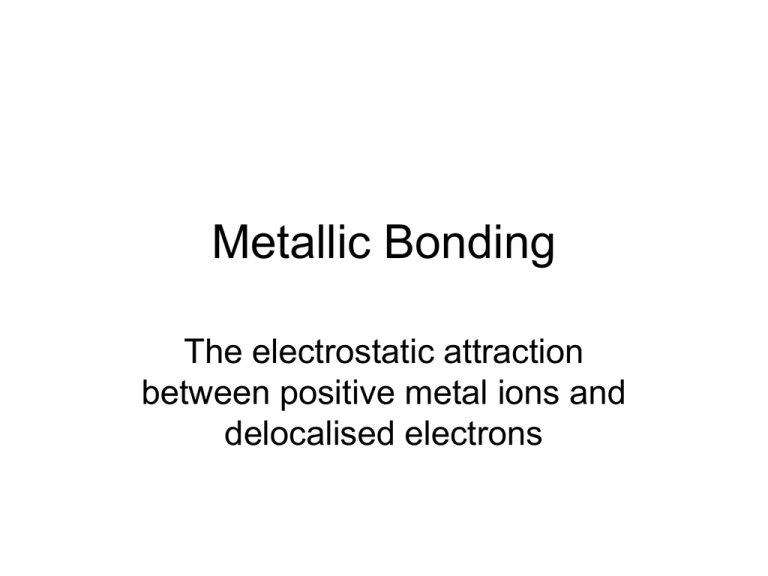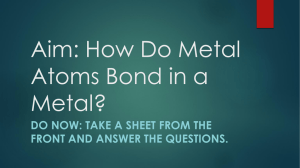Metallic Bonding - Macmillan Academy
advertisement

Metallic Bonding The electrostatic attraction between positive metal ions and delocalised electrons Learning Objectives • Define metallic bonding • Explain the properties of metals by linking to structure • Compare metallic and covalent bonding METALLIC BONDING Involves a lattice of positive ions surrounded by delocalised electrons Metal atoms achieve stability by “off-loading” electrons to attain the electronic structure of the nearest noble gas. These electrons join up to form a mobile cloud which prevents the newly-formed positive ions from flying apart due to repulsion between similar charges. Atoms arrange in regular close packed 3-dimensional crystal lattices. The outer shell electrons of each atom leave to join a mobile “cloud” or “sea” of electrons which can roam throughout the metal. The electron cloud binds the newly-formed positive ions together. METALLIC BOND STRENGTH Depends on the number of outer electrons donated to the cloud and the size of the metal atom/ion. Na K Mg The strength of the metallic bonding in sodium is relatively weak because each atom donates one electron to the cloud. The metallic bonding in potassium is weaker than in sodium because the resulting ion is larger and the electron cloud has a bigger volume to cover so is less effective at holding the ions together. The metallic bonding in magnesium is stronger than in sodium because each atom has donated two electrons to the cloud. The greater the electron density holds the ions together more strongly. METALLIC PROPERTIES Metals are excellent conductors of electricity For a substance to conduct electricity it must have mobile ions or electrons. Because the ELECTRON CLOUD IS MOBILE, electrons are free to move throughout its structure. Electrons attracted to the positive end are replaced by those entering from the negative end. MOBILE ELECTRON CLOUD ALLOWS THE CONDUCTION OF ELECTRICITY METALLIC PROPERTIES Metals can have their shapes changed relatively easily MALLEABLE CAN BE HAMMERED INTO SHEETS DUCTILE CAN BE DRAWN INTO RODS AND WIRES As the metal is beaten into another shape the delocalised electron cloud continues to bind the “ions” together. Some metals, such as gold, can be hammered into sheets thin enough to be translucent. METALLIC PROPERTIES HIGH MELTING POINTS Melting point is a measure of how easy it is to separate individual particles. In metals it is a measure of how strong the electron cloud holds the + ions. The ease of separation of ions depends on the... ELECTRON DENSITY OF THE CLOUD IONIC / ATOMIC SIZE PERIODS m.pt b.pt Na (2,8,1) < Mg (2,8,2) 98°C 890°C 650°C 1110°C Na+ Mg2+ < Al (2,8,3) 659°C 2470°C Al3+ MELTING POINT INCREASES ACROSS THE PERIOD THE ELECTRON CLOUD DENSITY INCREASES DUE TO THE GREATER NUMBER OF ELECTRONS DONATED PER ATOM. AS A RESULT THE IONS ARE HELD MORE STRONGLY. METALLIC PROPERTIES HIGH MELTING POINTS Melting point is a measure of how easy it is to separate individual particles. In metals it is a measure of how strong the electron cloud holds the + ions. The ease of separation of ions depends on the... ELECTRON DENSITY OF THE CLOUD IONIC / ATOMIC SIZE GROUPS m.pt b.pt Li (2,1) < Na (2,8,1) < K (2,8,8,1) 181°C 1313°C 98°C 890°C 63°C 774°C Li+ Na+ K+ MELTING POINT Decreases DOWN A GROUP IONIC RADIUS INCREASES DOWN THE GROUP. AS THE IONS GET BIGGER THE ELECTRON CLOUD BECOMES LESS EFFECTIVE HOLDING THEM TOGETHER SO THEY ARE EASIER TO SEPARATE. Alloys • Alloys are mixtures of metals: • They can mix together in different proportions to affect/modify the property of the alloy. • The ions of one metal can replace the ions of another in the structure. • Eg. Steel is an alloy of iron and carbon • Drill bits can be made of an alloy of vanadium and steel Compare metallic and covalent bonding 1. 2. 3. Multiple Q’s • • • • • • • • • Which would have the highest mpt? Why 1.Na, Mg, Al 2.Li Na K B. Draw the dative covalent bond between: 1. H20 + H+ 2. NH3 + H+ 3. NH3 + BF3 4. draw the NH2- ion and state bond angles 5 which of the following are polar?: F2 CH3Cl H2S C2H5OH. NH3 CCl4 H2O Dative covalent bonding • • • • 1. H20 + H+ 2. NH3 + H+ 3. NH3 + BF3 4. draw the NH2- ion and state bond angles • 5 which of the following are polar?: F2 CH3Cl H2S C2H5OH. NH3 CCl4 H2O






